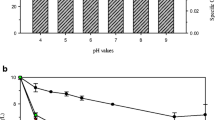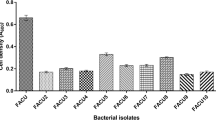Abstract
The Cr(VI)-reducing bacterial strain MCMB-821 was isolated from the alkaline crater lake of Lonar and was identified as Burkholderia cepacia. MCMB-821 was resistant to 1,000-ppm Cr(VI) and reduced 98% of the 75 ppm Cr(VI) within 36 h at pH 9.0 in the presence of 2% salt and lactose as the electron donor. The chromate-reducing efficiency of MCMB-821 was comparable under both aerobic as well as anaerobic conditions. Electron paramagnetic resonance spectroscopy data suggested that MCMB-821 reduced Cr(VI) to Cr(III) via the formation of transient Cr(V) intermediate. The chromate-reducing ability of MCMB-821 was suppressed in the presence of membrane inhibitors and enhanced in the presence of 2,4-dinitrophenol, suggesting the involvement of electron transport chain in the Cr(VI) bioreduction.




Similar content being viewed by others
References
Ackerley DF, Gonzalez CF, Keyhan M, Blake RII, Matin A (2004) Mechanism of chromate reduction by E. coli protein, NfsA, and the role of different chromate reductases in minimizing oxidative stresses during chromate reduction. Environ Microbiol 6:851–860
APHA–AWWA–WPCF (1985) Standard methods for the analysis of water and waste water. American Public Health Association, Washington, pp 201–204
Camargo FAO, Bento FM, Okeke BC, Frankenberger WT (2003) Chromate reduction by chromium resistant bacteria isolated from soils contaminated with dichromate. J Environ Qual 32:1228–1233
Chardin B, Dolla A, Chaspoul F, Fardeau ML, Gallice P, Bruschi M (2002) Bioremediation of chromate: thermodynamic analysis of effects of Cr(VI) on sulfate reducing bacteria. Appl Microbiol Biotechnol 60:352–360
Elangovan R, Abhipsa S, Rohit B, Philip L, Chandraraj K (2006) Reduction of Cr(VI) by a Bacillus sp. Biotechnol Lett 28:247–253
Jeyasingh J, Philip L (2005) Bioremediation of chromium contaminated soil: optimization of operating parameters under laboratory conditions. J Hazard Mater B 118:113–120
Kodam KM, Soojhawon I, Lokhande PD, Gawai KR (2005) Microbial reduction of reactive azo dyes under aerobic conditions. World J Microbiol Biotechnol 21:367–370
Kreig NR, Holt JG (1984) Gram-negative aerobic rods and cocci. In: Kreig NR, Holt JG (eds) Bergey’s manual of systematic bacteriology, vol I. Williams & Wilkins, Baltimore, pp 141–199
Liu YG, Xu WH, Zeng GM, Tang CF, Li CF (2004) Experimental study on Cr(VI) reduction by Pseudomonas aeruginosa. J Environ Sci (China) 16:797–801
Losi ME, Amrhein C, Frankenberger WT (1994) Environmental biochemistry of chromium. Rev Environ Contamin Toxicol 36:91–121
Mclean J, Beveridge TJ (2000) Chromate reduction by a pseudomonad isolated from a site contaminated with chromated copper arsenate. Appl Environ Microbiol 67:1076–1084
Middleton S, Latmani R, Mackey M, Elliman M, Tebo B, Criddle C (2003) Co-metabolism of Cr(VI) by Shewanella oneidensis MR-1 produces cell associated reduced chromium and inhibits growth. Biotechnol Bioeng 83:627–637
Myers CR, Carstens BP, Antholine WE, Myers JM (2000) Chromium (VI) reductase activity is associated with the cytoplasmic membrane of anaerobically grown Shewanella putrefaciens MR-1. J Appl Microbiol 88:98–106
Nieboer E, Jusys AA (1988) Biologic chemistry of chromium. In: Nriagu JO, Nieboer E (eds) Chromium natural and human environments. Wiley, New York, pp 21–79
Ougden K, Rigby K, Brooke DM (2004) Oxidative activation of the human carcinogen chromate by arsenite: a model for synergistic metal activation leading to oxidative DNA damage. Toxicol In Vitro 18:741–748
Pal A, Paul AK (2004) Aerobic chromate reduction by chromium resistant bacteria isolated from serpentine soil. Microbiol Res 159:347–354
Shen H, Wang YT (1993) Characterization of enzymatic reduction of hexavalent chromium by E. coli ATCC 33456. Appl Environ Microbiol 59:3771–3777
Thacker U, Madamwar D (2005) Reduction of toxic chromium and partial localization of chromium reductase activity in bacterial isolate DM1. World J Microbiol Biotechnol 21:891–899
Upreti RK, Shrivastava R, Chaturvedi UC (2004) Gut microflora and toxic metals: chromium as a model. Indian J Med Res 119:49–59
USEPA (1998) Toxicological review of hexavalent chromium. USEPA, Washington, DC, pp 1–64
Wang P, Mori T, Toda K, Ohtake H (1990) Membrane associated chromate reductase activity from Enterobacter cloacae. J Bacteriol 172:1670–1672
Wang CH, Huang CP, Saunders PF (2002) Transport of Cr(VI) in soils contaminated with chromate ore processing residue (COPR). Pract Period Hazard Toxic Radioact Waste Manag 6:6–13
Yadav S, Shukla OP, Rai UN (2005) Chromium pollution and bioremediation. Environews Newsletter of ISEB India 11:6–7
Yassi A, Nieboer E (1988) Carcinogenecity of chromium compounds. In: Nriagu JO, Nieboer E (eds) Chromium natural and human environments. Wiley, New York, pp 443–495
Acknowledgment
The authors thank Dr. Srinivas Darbha and L. Satyanarayana, National Chemical Laboratories, Pune, 411008, India, for the EPR analysis. The financial support provided by the University of Pune is acknowledged.
Author information
Authors and Affiliations
Corresponding author
Electronic supplementary material
Below is the link to the electronic supplementary material.
Table S1
Characteristics of strain MCMB-821 (DOC 50 kb)
Rights and permissions
About this article
Cite this article
Wani, R., Kodam, K.M., Gawai, K.R. et al. Chromate reduction by Burkholderia cepacia MCMB-821,isolated from the pristine habitat of alkaline crater lake. Appl Microbiol Biotechnol 75, 627–632 (2007). https://doi.org/10.1007/s00253-007-0862-7
Received:
Revised:
Accepted:
Published:
Issue Date:
DOI: https://doi.org/10.1007/s00253-007-0862-7




